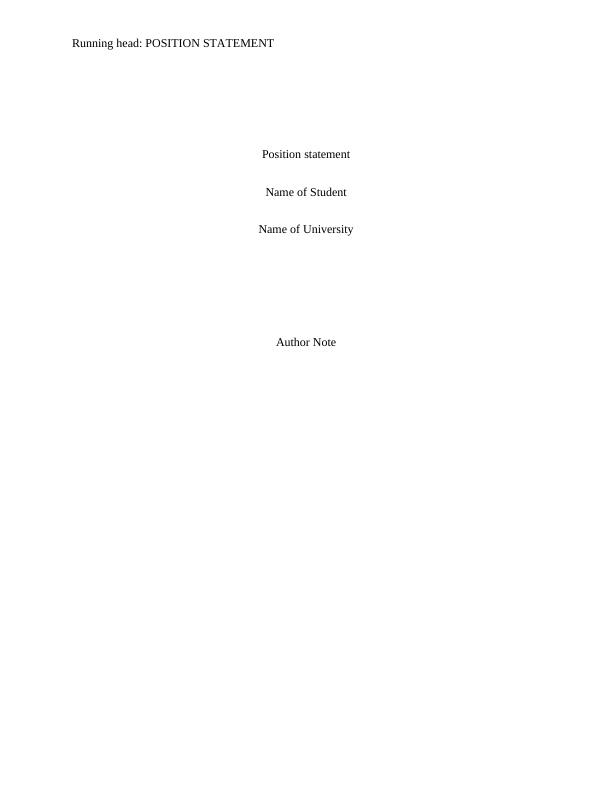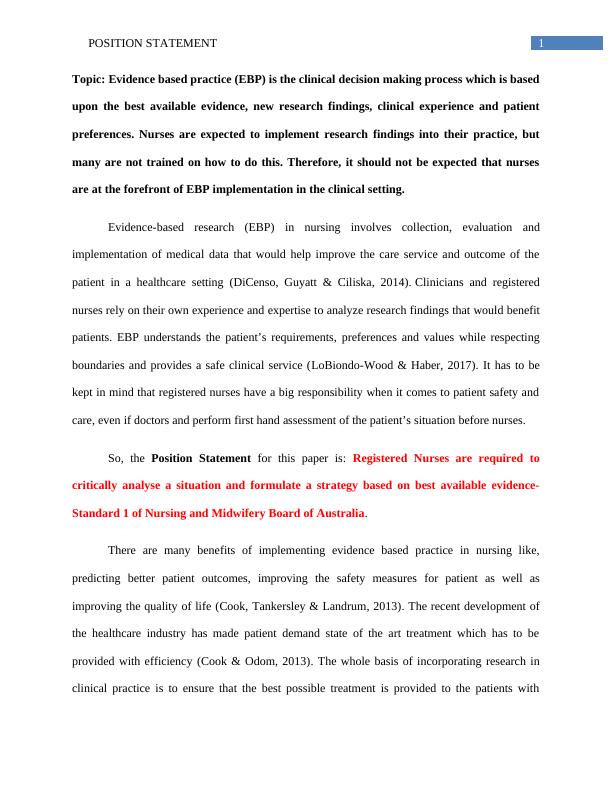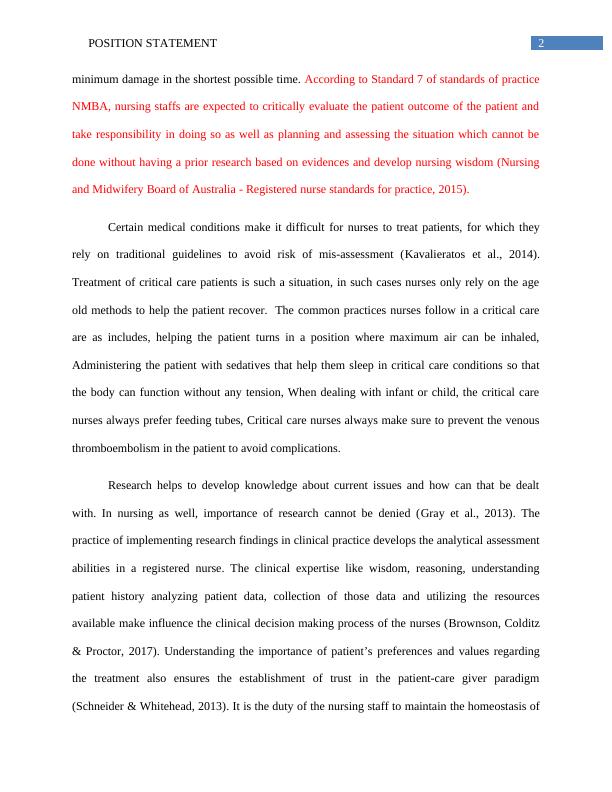Evidence Based Practice (EBP) - PDF
10 Pages2364 Words153 Views
Added on 2021-04-16
Evidence Based Practice (EBP) - PDF
Added on 2021-04-16
ShareRelated Documents
Running head: POSITION STATEMENTPosition statementName of StudentName of UniversityAuthor Note

1POSITION STATEMENTTopic: Evidence based practice (EBP) is the clinical decision making process which is basedupon the best available evidence, new research findings, clinical experience and patientpreferences. Nurses are expected to implement research findings into their practice, butmany are not trained on how to do this. Therefore, it should not be expected that nursesare at the forefront of EBP implementation in the clinical setting. Evidence-based research (EBP)in nursing involves collection, evaluation andimplementation of medical data that would help improve the care service and outcome of thepatient in a healthcare setting (DiCenso, Guyatt & Ciliska, 2014).Clinicians and registerednurses rely on their own experience and expertise to analyze research findings that would benefitpatients. EBP understands the patient’s requirements, preferences and values while respectingboundaries and provides a safe clinical service (LoBiondo-Wood & Haber, 2017). It has to bekept in mind that registered nurses have a big responsibility when it comes to patient safety andcare, even if doctors and perform first hand assessment of the patient’s situation before nurses. So, the Position Statement for this paper is:Registered Nurses are required tocritically analyse a situation and formulate a strategy based on best available evidence-Standard 1 of Nursing and Midwifery Board of Australia.There are many benefits of implementing evidence based practice in nursing like,predicting better patient outcomes, improving the safety measures for patient as well asimproving the quality of life (Cook, Tankersley & Landrum, 2013). The recent development ofthe healthcare industry has made patient demand state of the art treatment which has to beprovided with efficiency (Cook & Odom, 2013). The whole basis of incorporating research inclinical practice is to ensure that the best possible treatment is provided to the patients with

2POSITION STATEMENTminimum damage in the shortest possible time. According to Standard 7 of standards of practiceNMBA, nursing staffs are expected to critically evaluate the patient outcome of the patient andtake responsibility in doing so as well as planning and assessing the situation which cannot bedone without having a prior research based on evidences and develop nursing wisdom (Nursingand Midwifery Board of Australia - Registered nurse standards for practice, 2015).Certain medical conditions make it difficult for nurses to treat patients, for which theyrely on traditional guidelines to avoid risk of mis-assessment (Kavalieratos et al., 2014).Treatment of critical care patients is such a situation, in such cases nurses only rely on the ageold methods to help the patient recover. The common practices nurses follow in a critical careare as includes, helping the patient turns in a position where maximum air can be inhaled,Administering the patient with sedatives that help them sleep in critical care conditions so thatthe body can function without any tension, When dealing with infant or child, the critical carenurses always prefer feeding tubes, Critical care nurses always make sure to prevent the venousthromboembolism in the patient to avoid complications.Research helps to develop knowledge about current issues and how can that be dealtwith. In nursing as well, importance of research cannot be denied (Gray et al., 2013). Thepractice of implementing research findings in clinical practice develops the analytical assessmentabilities in a registered nurse. The clinical expertise like wisdom, reasoning, understandingpatient history analyzing patient data, collection of those data and utilizing the resourcesavailable make influence the clinical decision making process of the nurses (Brownson, Colditz& Proctor, 2017). Understanding the importance of patient’s preferences and values regardingthe treatment also ensures the establishment of trust in the patient-care giver paradigm(Schneider & Whitehead, 2013). It is the duty of the nursing staff to maintain the homeostasis of

End of preview
Want to access all the pages? Upload your documents or become a member.
Related Documents
Evidence-Based Practice Nursing Assignmentlg...
|10
|2475
|833
NRSG367 Transition To Professional Nursing: Assignmentlg...
|10
|2193
|48
Evidence for Nursing: Understanding Research Conceptslg...
|6
|2703
|77
Position Statement Assignment PDFlg...
|10
|2543
|36
Evidence Based Nursing Researchlg...
|10
|2694
|485
Critical Review Assignment 2022lg...
|18
|4044
|50
